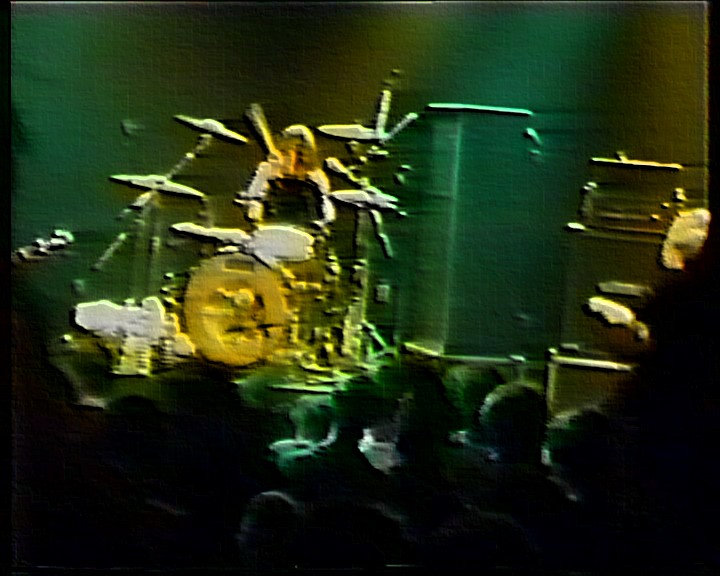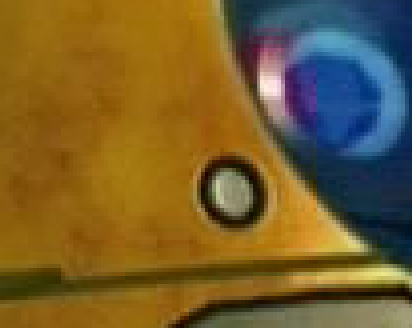Hi guys , like i said in other threads , i can't know what is happening..
I had the DV500 , the problem began.....
I have the Canopus ADVC 50 , and the problem continues with difficult tapes ,
maybe DV format is useless for a vhs transfer.
Normal picture eh?
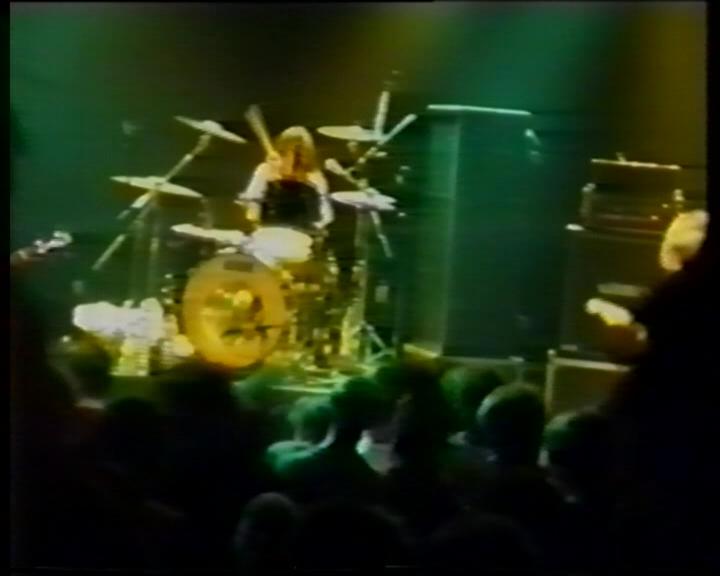
+ Reply to Thread
Results 1 to 30 of 41
-
-
I am becoming crazy with those lines...... Only appears in difficult tapes , they are not visible in normal tapes. I had this problem with my DV500 with all the tapes but with the canopus advc , no
I really want to know WHY it have to appear , some DV faults? Interferences?
Thanks -
I've had some footage like that. What I did was capture it in uncompressed YUY2, no filter was turned on in my JVC VCR, with my Vidicraft Detailer II set to add some detail and sharpness, adjusted the proc amp on my capture card to correct the color. Filtered it with avisynth. Once encoded, it looked OK not great, but it was better than the original.
The thing with DV, if your in NTSC, you loose color quality. DV uses 4:1:1 compared to 4:2:2 for most analogue capture. Your VCR should also put out 4:2:2. I believe Spain is PAL though correct?
But, with that footage, I'd import into Vegas, correct the color. Output back to DV, then run through avisynth with a light noise reduction, followed by slight edge enhancement. The main problem is the bad color though.
The lines are either interlace or chorma noise. Hard to tell with out seeing a moving picture. The lines remain parallal, it's interlace. If the vertical position changes, like they are waving, it's noise. Try cleaning the VCR or perhaps get a higher quality playback unit if it's needed. To clean the VCR, insert a new blank tape, and just have it record something/anything for a few minutes. You really shouldn't use a tape cleaner -
i have used some noise reduction filters and the problem continues. It is part of the picture , i think that i can't remove it. I am speaking about removing it with software.
-
DV uses a DCT compression scheme very similar to MPEGs. So it can create macroblocks and DCT artifacts. That's what you're seeing. You can try using MSU's deblocking filter in VirtualDub. It helps a little bit.
-
VHS demodulated chroma U and V bandwidth is less than 1MHz (500-600KHz typical). VHS luminance bandwidth is 3MHz maximum.Originally Posted by disturbed1
In terms of 4:1:1 sampling, VHS is around 1.8 : 0.3 : 0.3
In other words 13.5MHz* luminance and 3.375MHz* chroma sampling (4:1:1) is more than enough for VHS. 4:1:1 sampling is more than enough for Betacam SP.
* Effective maximum analog bandwidth is half the sample frequency (aka Nyquist bandwidth). So for 4:1:1 sampling effective analog bandwidth is 6.75MHz for luminance and 1.7 MHz for chroma components. VHS falls way short of that.Recommends: Kiva.org - Loans that change lives.
http://www.kiva.org/about -
Really?
Then it just must be a bad DV codec (Canopus) that squashed the color on my ADVC VHS transfers, and adds the squaring of round red sources. Makes red balls look like red squares. Even though YUY2 and MJPEG doesn't.
Perhaps I sold the machine for nothing.
NTSC standard VHS color is 3.58MHZ, though some tapes are mastered at 4.43MHZ. -
Something is going on but it isn't sample rate.
With a good S-Video input, this is what a ADVC-100 looks like.
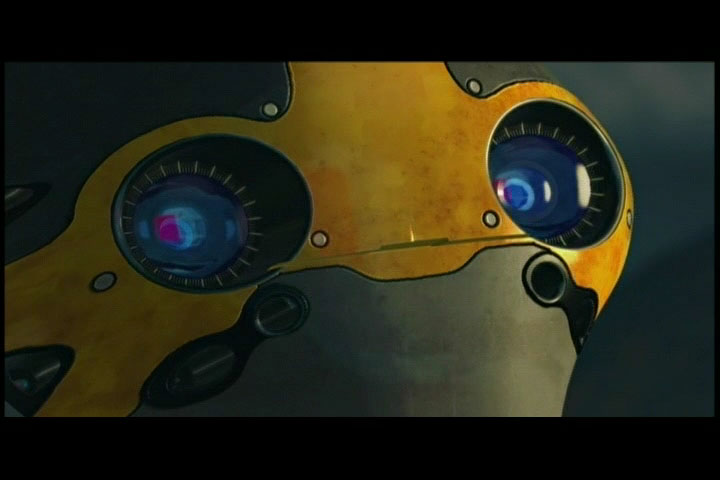
Added: This picture was realtime encoded from DV to MPeg2 with the Mainconcept encoder in Video Studio 8.Recommends: Kiva.org - Loans that change lives.
http://www.kiva.org/about -
Here's what NTSC DV does to the color
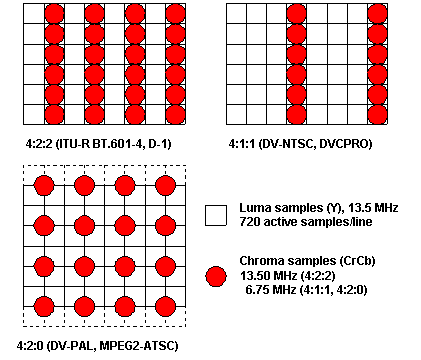
And now capture a round red ball. Like a balloon or something. -
3.58MHz is the NTSC color subcarrierOriginally Posted by disturbed1
4.43MHz is the PAL color subacrrier
Luminance in both cases is limited to 3MHz
Can you show a uncompressed or MJPeg capture of the same scene?Recommends: Kiva.org - Loans that change lives.
http://www.kiva.org/about -
Don't know what movie that is. Let me know, I can do upto 704x480 7MB/sec.
Let me know what movie that is. I have to go some where in a few. So I'll get on it later tonight, early tomorrow. -
For VHS there is no loss due to DV sampling. The color resolution is only 600KHz or about 50 visible segments along a horizontal line. DV samples u and v color 180 times along the line or 3x.
Here is analog S-Video into the ADVC-100 off the HD cable box. Do you see serious sample loss?
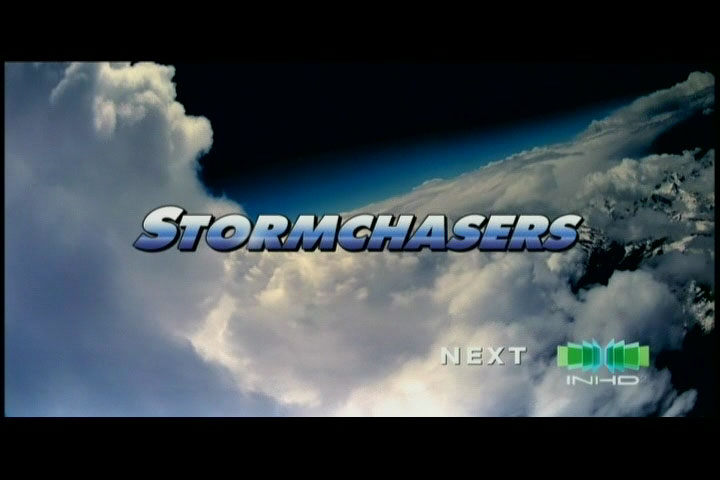
Added: This picture was realtime encoded from DV to MPeg2 with the Mainconcept encoder in Video Studio 8.Recommends: Kiva.org - Loans that change lives.
http://www.kiva.org/about -
Macroblocks come from realtime MPeg2 encoder (a mainconcept). They aren't bad at 1x. That isn't DV.
Recommends: Kiva.org - Loans that change lives.
http://www.kiva.org/about -
Originally Posted by edDV??? I suppose the other one wasn't DV either?Originally Posted by edDV
Originally Posted by edDV
-
It was on discovery channel
Recommends: Kiva.org - Loans that change lives.
http://www.kiva.org/about -
ADVC DV off ABC KPAX movie.
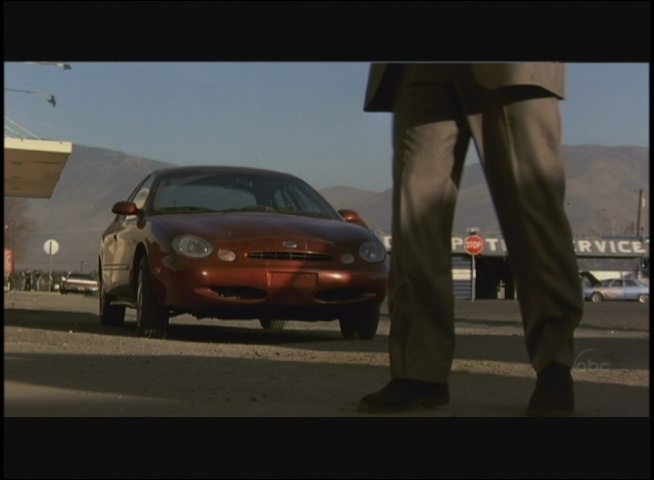
ADVC DV live 480i
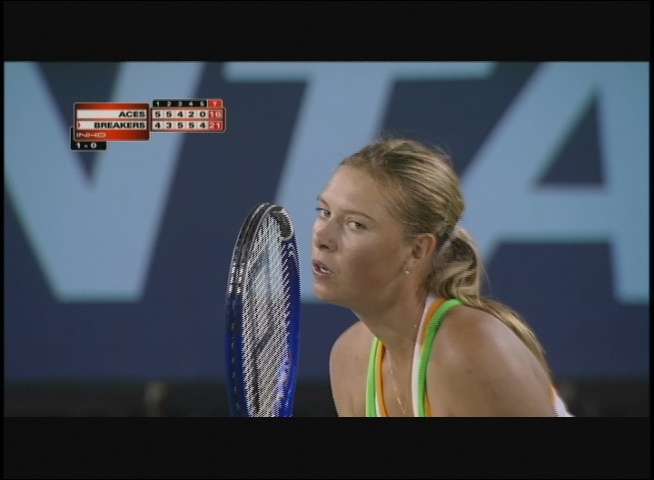 Recommends: Kiva.org - Loans that change lives.
Recommends: Kiva.org - Loans that change lives.
http://www.kiva.org/about -
Keep in mind this is 480i.
The stills show interlace but color sample fidelity isn't bad.
For comparison here is Y only
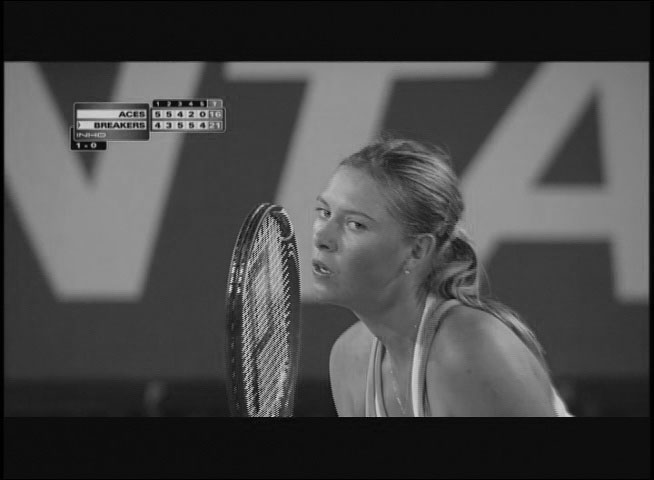 Recommends: Kiva.org - Loans that change lives.
Recommends: Kiva.org - Loans that change lives.
http://www.kiva.org/about -
Still waiting on what that movie is, and a capture of a red ball.
Here's some straight forward info on color primaries.
Granted it is comparing 4:2:2 conversions vs 4:1:1 conversions. But common sense should tell us all, it is better to go from 4:2:0 to 4:2:0 (DVD output) then attempting to upsample 4:1:1 to 4:2:0. It is impossible to recreate information that is not there.Originally Posted by http://videoexpert.home.att.net/artic3/256dvcr.htm
There's plenty of info out there about the bad quality NTSC analouge to DV conversions. Do a search on this forum, google, or any other video forum. They all talk about the negatives. DV does make it easier to edit, but the picture is just not as nice, unless of course you use filters to smooth the picture, which can be seen by the rounding of neighboring pixels
-
Here's a locked camera shot that allows us to separate interlace affects from 4:1:1 480i sample rate
These caps are DV off ADVC connected S-Video to a Motorola DCT-6200 cable box.

At 200% 4:1:1 is holding well
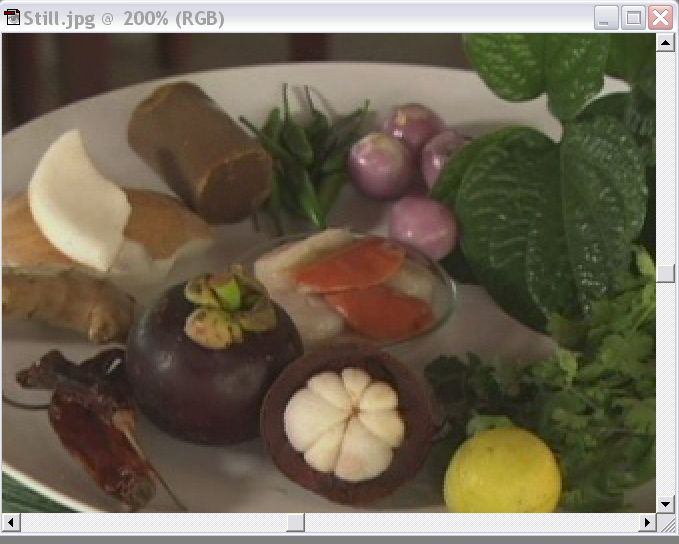
At 400% the Y sampling is more visible than wide color pixels.
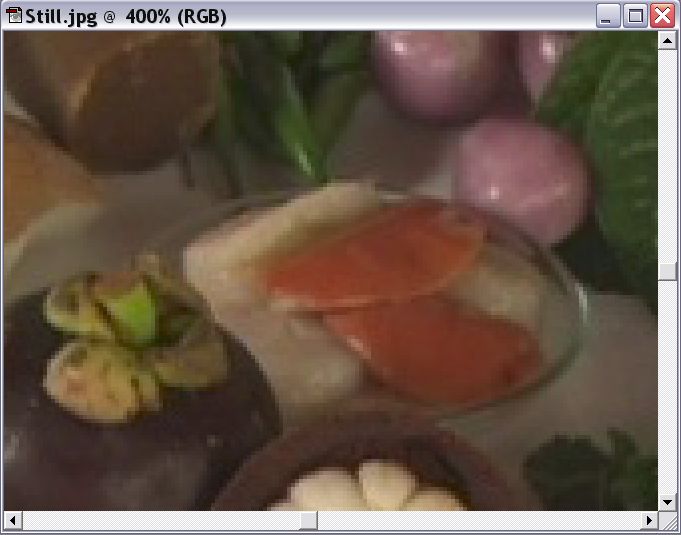
Monochrome shows this.
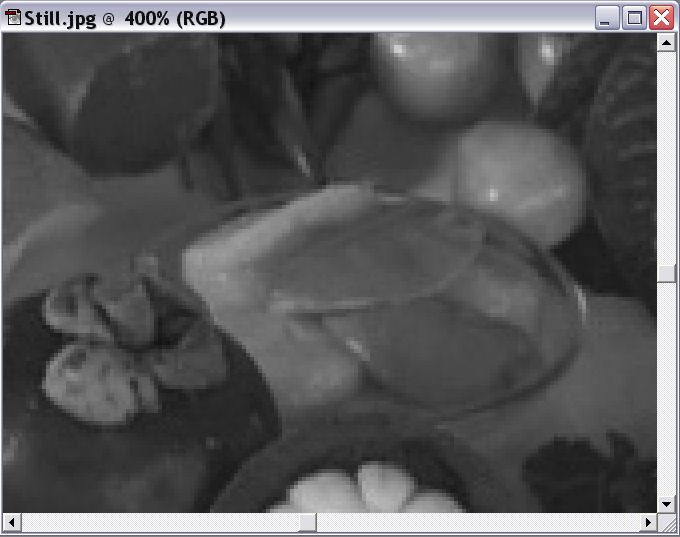
The first robot shot was a Discovery Channel program on Darwin Project.Recommends: Kiva.org - Loans that change lives.
http://www.kiva.org/about -
[quote="disturbed1"]
This assumes the human eye can resolve color to the line when it actually has difficulty resolving color over 4 lines. That is the entire idea behind 4:2:0.Originally Posted by http://videoexpert.home.att.net/artic3/256dvcr.htm
Well true but 4x4 blocks are about the limits of human color response.Originally Posted by http://videoexpert.home.att.net/artic3/256dvcr.htm
All this is mute because we users do not have access to uncompressed 4:2:2 source resolution. You can't get any benefit from oversampling a low resolution source. Garbage in results in worse garbage out. VHS would contain a constant chroma value over 4 Y samples regardless of sample rate be it 4:1:1, 4:2:2 or 4:4:4
It is an interpolation in either case.Originally Posted by disturbed1
4:1:1 has a significant benefit for multigeneration since the chroma pixels are not interpolated for each pass.
Nice compared to what? Uncompressed 4:2:2 capture or 4:2:2 MJPEG?Originally Posted by disturbed1
I wish I had my DC30+ connected.
More to come.Recommends: Kiva.org - Loans that change lives.
http://www.kiva.org/about -
Ahh I found the paper I was looking for. Great stuff.
http://www.nattress.com/Chroma_Investigation/chromasampling.htmRecommends: Kiva.org - Loans that change lives.
http://www.kiva.org/about -
That's what I have, a DC30 PRO. I upgraded to an ADVC for about month. Sold it and went back to the DC30 because of the quality issues using the ADVC capturing (S)VHS tapes. Could not handle the stair step on round red items. Images also seemed nowhere near as sharp nor detailed when compared with the DC30.
Could of been the encoder, Canopus Pro Coder Express, DV Codec? (Canopus DV Codec). Either way, Pro Coder Express encodes my MJPEG captures with a better output, than it did DV.
I notice this problem with reds even watching TV. Most of the commercials for local businesses have this problem. Some shows do to. You can tell either the cable company is encoding improperly, or the original filming was done with a consumer grade DV camera.
True, most people may not be able to notice this. Same with the incorrect telecine process that is also done by my cable company on many channels, and the bad dynamic compression done on most films. BUT, if I notice it, it is right
-
Thanks, it just talks about how flawed 4:1:1 to 4:2:0 conversion is.Originally Posted by edDV
Basically, he is working with final cut pro, using apple's smooth dv filter to over come the limitations of the NTSC DV Codec and up-conversion problems. -
"Thanks, it just talks about how flawed 4:1:1 to 4:2:0 conversion is."Originally Posted by disturbed1
I didn't read that into his comments. He concluded that 4:1:1 properly decompressed to SMPTE 259M SDI will outperform Betacam SP (better Y performance) and blends well with 8 bit 4:2:2.
I haven't done much VHS capture with the DC-30plus but the DV equipment wins for high quality souces due to Y performance. DV is much more efficiently compressed in Y. DV Y performance equals 8 bit digital Betacam where MJPEG falls short even at 8MB/s (64Mb/s) datarates. On the other hand MJPEG is chroma sampled in 4:2:2.
For VHS I don't understand how 4:2:2 comes into play since VHS chroma still falls short of 4:1:1 bandwidth by 2-3x. It may have something to do with higher resolution noise. In pro gear, a low pass filter removes this high frequency noise before A/D.Recommends: Kiva.org - Loans that change lives.
http://www.kiva.org/about -
I don't know either.
I do agree, that when using the ADVC with an S-Video input from my cable box, if there was a difference between the DV and MJPEG, I didn't care enough to notice, other than a stair step problem with red objects.
But, coming from my JVC S-VHS to a Vidi Craft Detailer, there was a marked improvement with the DC30, even a YUY2 capture with a BT878 chip looked better. But I would choose DV over YUY2 just because of size and the fact the DV is faster to enocode. Even bypassing everything, setting the JVC in edit mode, and using both/either composite and S-Video the DC30 appeared better to my eyes. -
I'll have to try it next time I fire up for DC30 MJPEG. My sources then were Betacam SP when I used that card. The DC-30 is well matched to SP but the HDD consumption @ 8MB/s kept my projects short.
VHS capture wasn't an option with expensive SCSI RAIDs with 40min total recording capacity.Recommends: Kiva.org - Loans that change lives.
http://www.kiva.org/about -
So , what is the solution? With a better pro card , like Pinnacle Dc1000 which can capture mpeg2 in realtime , i could have the same problem?
Also , i had the Dc30 but it capture the audio only at 44 hz . I should use other drivers for capture the audio from my sound blaster.
And the problem number 2 , was the frames dropped . The quality was the best. -
Yep, the 44.1 audio is a killer. But I resample during my audio editing with Sound Forge.
I've only dropped a few frames in all my years of using my DC30. It's recording to (now) 2 200gig Seagate drives in a RAID 0 config. I've also used it with single 40-120gig 7200rpm Maxtor drives. Once in a while it would drop a frame or 2 during a long 1 hour plus capture, but only if using the max bitrate. I usually just set it to around 6MB/sec now.
Using other drivers could be the whole reason for the frame drop. Also the hacked drivers, and unofficial WinXP drivers do not work well. For one, it only allows 640x480 capture, and disables the sound portion of the card. I use the official Pinnacle drivers, and Pinnacle capture app on Windows 2000 with the no 2gig reg hack to achieve captures over 2gigs. Import into Virtual Dub to rewrite the avi header, edit then encode with either TMPG or Pro Coder Express.
Similar Threads
-
Looking around for a solution to this problem.
By chrisyroid in forum Camcorders (DV/HDV/AVCHD/HD)Replies: 2Last Post: 8th May 2010, 09:44 -
Help me find the right solution please.
By abeaty in forum Video ConversionReplies: 8Last Post: 7th May 2010, 23:12 -
4:3 and 16:9 on same DVD - solution
By sergem1 in forum Authoring (DVD)Replies: 6Last Post: 15th Jan 2010, 03:03 -
RIAA Executives commit mass suicide
By thecoalman in forum Off topicReplies: 2Last Post: 22nd Oct 2007, 01:32 -
Need Streaming Solution
By jadude in forum Capturing and VCRReplies: 1Last Post: 6th Oct 2007, 19:17





 Quote
Quote